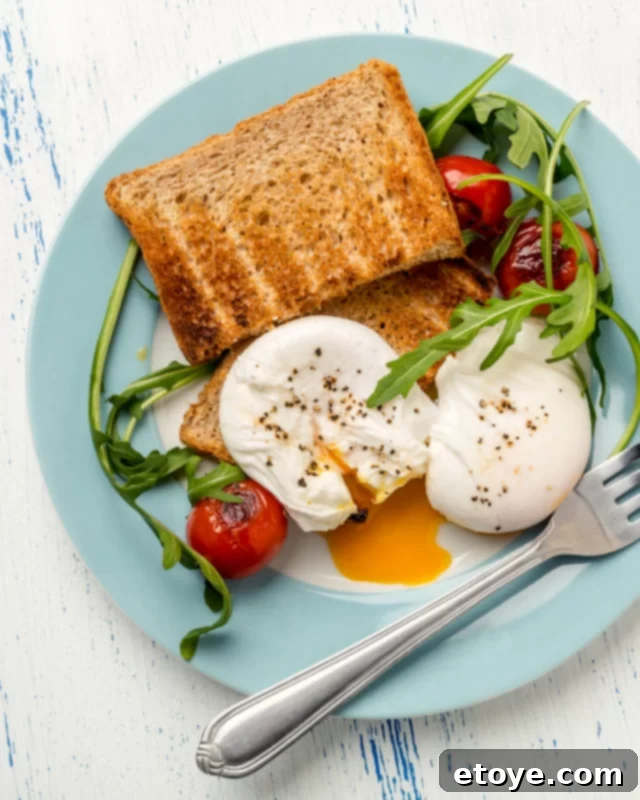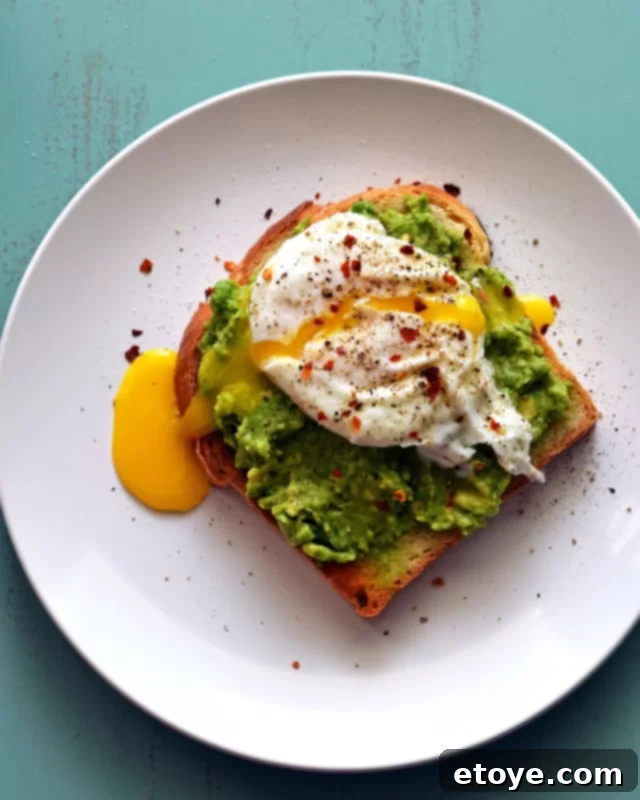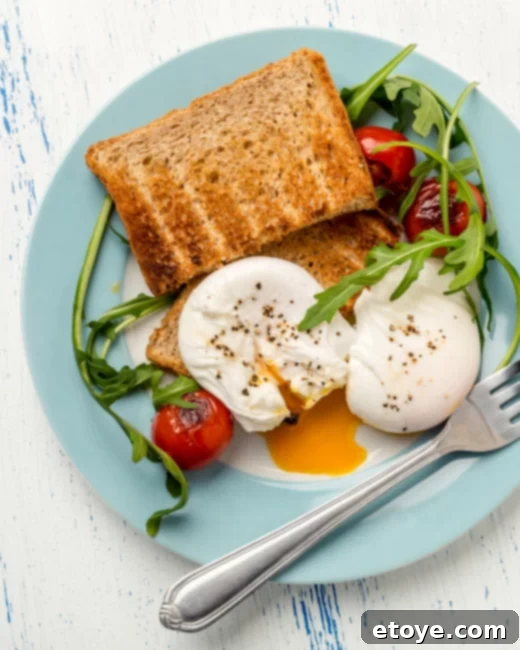Perfect Poached Eggs in Minutes: Your Ultimate Microwave Guide
Imagine serving restaurant-quality poached eggs right from your own kitchen, effortlessly and in mere minutes. This culinary dream is now a reality, thanks to a simple yet ingenious technique: microwave poaching. Forget the fuss, the swirling water, and the delicate art of stovetop poaching that often feels more like a science experiment. With this straightforward microwave poached eggs recipe, you’re just moments away from enjoying perfectly cooked eggs, ideal for a luxurious Eggs Benedict, a healthy breakfast bowl, or simply topping your favorite toast.

This method revolutionizes how you prepare one of the most elegant egg dishes. It’s incredibly fast and easy, allowing you to bypass the traditional challenges entirely. No more waiting for water to boil, no more wrestling with egg whites in a swirling vortex. While the microwave might not always produce the perfectly spherical, picture-book poached egg, it consistently delivers an undeniably delicious and flawlessly cooked result. If you adore eggs benedict but lack the time or inclination to master the conventional poaching “technique,” then this quick microwave solution is an absolute game-changer. It opens up a world of gourmet breakfast and brunch possibilities, making healthy, protein-rich meals accessible even on the busiest mornings.
Why This Microwave Poached Egg Recipe is a Must-Try
In today’s fast-paced world, convenience without compromising quality is highly sought after, especially in the kitchen. This microwave poaching method stands out for several compelling reasons:
- Effortless Excellence: Achieve the delicious taste and texture of restaurant-quality poached eggs without needing any specialized skills or complicated techniques. It truly democratizes the art of poaching.
- Nutrient Powerhouse: Eggs are an incredible source of high-quality protein, essential vitamins, and minerals. Starting your day with a poached egg provides a substantial energy boost, keeping you full and focused.
- Unbeatable Speed: From cracking the egg to plating your perfectly cooked masterpiece, the entire process takes less than five minutes. Say goodbye to boiling pots and lengthy preparation, making it perfect for weekday mornings or a quick, healthy snack.
- Minimal Cleanup: Unlike stovetop methods that can involve multiple pots and utensils, microwave poaching requires just one bowl and a plate, simplifying your post-meal cleanup.
- Consistent Results: Once you’ve fine-tuned the cooking time for your microwave, you can expect consistently perfect eggs every single time, taking the guesswork out of poaching.
The Simple Ingredients You’ll Need

One of the beauties of this recipe lies in its simplicity, requiring only a handful of common kitchen staples. Each ingredient plays a crucial role in ensuring a perfectly poached egg:
- Eggs: The star of our show! Fresh eggs are key for the best results, as their whites are firmer and hold together better. Aim for large eggs for standard serving sizes.
- Water: Provides the medium for cooking the egg. The water gently steams the egg, allowing it to cook evenly without direct contact with the microwave’s intense heat.
- Vinegar: A small amount of white vinegar (or apple cider vinegar) added to the water helps the egg whites set faster and more cohesively. This prevents wispy, stringy whites and encourages a neat, compact poached egg. Don’t worry, you won’t taste it!
- Salt and Pepper: Essential for seasoning to taste. These are added after cooking, enhancing the natural flavors of the egg.
Essential Equipment
To embark on your microwave poaching journey, you’ll need just a few basic items:
- Microwave-Safe Bowl: A small, microwave-safe bowl (like a cereal bowl or ramekin) is perfect. Ensure it’s deep enough to fully submerge the egg in water.
- Small Plate or Lid: To cover the bowl during cooking, which helps trap steam and ensures even cooking, while also preventing any potential splatters.
- Toothpick or Cake Tester: Crucial for gently piercing the egg yolk, a vital step for safety and perfect results.
How to Cook Perfect Poached Eggs in the Microwave
Follow these straightforward steps to achieve perfectly poached eggs every time. Remember, microwave wattages can vary, so the cooking times provided are a guideline – feel free to adjust as needed for your specific appliance.
- Prepare Your Poaching Bath: In your microwave-safe bowl, combine approximately ⅓ cup of water with ½ teaspoon of vinegar. The water should be enough to fully cover the egg.
- Gently Add the Egg: Carefully crack one egg into the water-vinegar mixture. Take care not to break the yolk.
- The Crucial Yolk Prick: Using a toothpick or a cake tester, gently poke a small hole in the center of the egg yolk. This vital step allows steam to escape during cooking, preventing the egg from exploding in your microwave and ensuring an even cook.
- Microwave with Caution: Cover the bowl with a microwave-safe plate or lid. Microwave at 50% power for one minute. Cooking at reduced power prevents the egg from cooking too rapidly or unevenly, resulting in a more tender texture.
- Check for Doneness and Adjust: Carefully remove the bowl (it will be hot!). Check the egg for doneness. A perfectly poached egg should have an opaque, set white and a beautifully runny yolk. If the white isn’t fully set or the yolk isn’t at your desired consistency, return it to the microwave and continue cooking in 15-second intervals at 50% power until it reaches your preference.
- Season and Serve: Once cooked to perfection, carefully remove the poached egg from the water using a slotted spoon. Gently pat dry with a paper towel if desired. Sprinkle with salt and freshly ground black pepper. Serve immediately and enjoy!

The hallmark of a truly great poached egg is its contrast: a delicate, firm white enveloping a rich, velvety runny yolk. The secret to consistently achieving this texture with the microwave method lies in precise timing and power settings. Microwaves are powerful appliances, which is why we recommend using 50% power to prevent overcooking or a rubbery texture. Don’t be afraid to experiment with the cooking duration to discover the ideal timing for your specific microwave and to achieve your preferred yolk consistency – whether you like it perfectly runny, slightly jammy, or even fully firm.
Tips for Microwave Poaching Perfection
- Fresh Eggs are Best: The fresher the egg, the firmer its white, which helps it hold its shape better during poaching.
- Don’t Skip the Vinegar: A small splash of vinegar (white or apple cider) in the water helps the egg whites coagulate faster, resulting in a more compact and less wispy poached egg. You won’t taste it!
- Always Pierce the Yolk: This is crucial! Poking a tiny hole in the yolk prevents steam buildup, which can cause the egg to explode in the microwave.
- Start with Cold Water: Using cold water allows the egg to cook more gently and evenly, reducing the risk of a rubbery white while the yolk is still undercooked.
- Adjust Power and Time: All microwaves vary. Starting at 50% power for one minute is a good baseline, but you may need to adjust slightly. If your egg is overcooked, reduce the time or power. If it’s undercooked, add 10-15 second increments.
- One Egg at a Time: For best results and even cooking, poach one egg at a time. If you need multiple eggs, simply repeat the process for each.
Troubleshooting Common Microwave Poached Egg Issues
Even with the simplest recipes, challenges can arise. Here are solutions to common problems you might encounter:
- Egg Exploded in the Microwave: This is almost always due to not piercing the yolk. Ensure you make a small hole in the yolk before cooking to allow steam to escape safely.
- Egg White is Still Runny, Yolk is Cooked: This could mean your egg wasn’t fresh enough (fresh eggs have tighter whites) or you didn’t use enough vinegar to help the white set quickly. Ensure your water also adequately covers the egg.
- Egg is Rubbery or Overcooked: Your microwave might be more powerful, or you cooked it for too long. Reduce the initial cooking time or decrease the power level (e.g., try 40% power).
- Yolk is Too Firm (or Too Runny): This is a matter of personal preference and microwave calibration. For a softer yolk, reduce cooking time. For a firmer yolk, add short 10-15 second bursts until it reaches your desired consistency.
Serving Suggestions for Your Microwave Poached Eggs
Once you’ve mastered the art of microwave poaching, a world of culinary possibilities opens up. These versatile eggs can elevate almost any meal:
- Classic Eggs Benedict: The quintessential choice! Top toasted English muffins with Canadian bacon, your microwave poached egg, and a drizzle of hollandaise sauce.
- Avocado Toast: A modern favorite. Layer sliced or mashed avocado on toasted bread, then crown it with a perfectly poached egg and a sprinkle of chili flakes.
- Breakfast Bowls: Combine with roasted vegetables, quinoa, or greens for a hearty and healthy start to your day.
- Salad Topper: A warm, runny poached egg adds richness and protein to any green salad. The yolk acts as a natural dressing!
- Ramen or Noodle Bowls: Drop a poached egg into your hot ramen or noodle soup for an extra layer of flavor and protein.
- Simple Toast: Sometimes, simplicity is best. A poached egg on a piece of buttered toast, seasoned well, is pure comfort food.

Frequently Asked Questions (FAQs) About Microwave Poached Eggs
How can I poach an egg with a firm or soft yolk?
Achieving your desired yolk consistency is all about adjusting the cooking time. For a wonderfully runny, soft yolk, follow the recipe as written, typically around 1 minute at 50% power after piercing the yolk. If you prefer a firmer, jammy yolk, microwave for an additional 15-second increment at 50% power until it reaches your preferred level of doneness. Remember to check carefully after each interval to avoid overcooking.
Why do you poke a small hole in the yolk?
Poking a tiny hole in the yolk is a critical safety step when cooking eggs in the microwave. The yolk’s membrane traps steam, which can build up pressure and cause the egg to explode. Creating a small vent allows this steam to escape harmlessly, preventing a mess and ensuring your egg cooks safely and evenly.
Can I poach multiple eggs at once in the microwave?
While technically possible in a larger bowl, it’s generally recommended to poach one egg at a time for the best and most consistent results. Cooking multiple eggs simultaneously can lead to uneven cooking, where some eggs might be perfectly done while others are under or overcooked. The small effort of cooking them individually is usually worth the superior outcome.
What type of bowl is best for microwave poaching?
A small, microwave-safe ceramic or glass bowl, such as a ramekin or a standard cereal bowl, works perfectly. Ensure the bowl is deep enough to fully submerge the egg in water. Using a clear bowl can also help you monitor the egg’s progress during cooking.
What if I don’t have vinegar? Can I still make poached eggs?
Yes, you can still poach eggs in the microwave without vinegar. However, the vinegar helps the egg whites set more quickly and maintain a compact shape. Without it, your egg whites might be a bit more wispy or spread out in the water. The taste will not be affected, so if you’re out of vinegar, don’t let it stop you!
Is it safe to cook eggs in the microwave?
Absolutely! When done correctly, with the crucial step of piercing the yolk, cooking eggs in the microwave is perfectly safe. The primary concern is steam buildup within the yolk, which is mitigated by piercing. Always use microwave-safe dishes and follow instructions to prevent any mishaps.
Can I use warm water instead of cold water?
While some recipes suggest starting with warm water, using cold water allows for a more gentle and gradual cooking process, which can help prevent the whites from becoming rubbery before the yolk is perfectly cooked. It provides a more consistent result for microwave poaching.
Recipe: Poached Eggs in the Microwave

Creating restaurant-quality poached eggs at home has never been easier or faster. This simple microwave poached eggs recipe delivers delicious, perfectly cooked eggs in under five minutes, making them ideal for an Eggs Benedict, avocado toast, or any meal that benefits from a luscious, runny yolk.
Prep Time: 1 minute
Cook Time: 2 minutes
Total Time: 3 minutes
Course: Breakfast
Cuisine: American
Servings: 1
Calories: 65 kcal
Ingredients
- 1 large egg
- ⅓ cup of water
- ½ tsp of white or apple cider vinegar
- Salt & freshly ground black pepper, to taste
Instructions
- Fill a microwave-safe bowl with ⅓ cup of water and ½ teaspoon of vinegar.
- Carefully crack one egg into the bowl, ensuring the yolk remains intact.
- Using a toothpick or a cake tester, gently poke a small hole in the center of the egg yolk to allow steam to escape.
- Cover the bowl with a microwave-safe plate or lid. Microwave at 50% power for 1 minute.
- Carefully remove the bowl (it will be hot). Check the egg for doneness; the white should be set, and the yolk runny. If needed, continue microwaving in 15-second intervals at 50% power until your desired doneness is achieved.
- Using a slotted spoon, carefully remove the poached egg from the water. Season with salt and pepper to taste and serve immediately. Enjoy!
Nutrition Information (per serving)
- Serving: 1g
- Calories: 65 kcal
- Carbohydrates: 1g
- Protein: 6g
- Fat: 4g
- Saturated Fat: 1g
- Trans Fat: 1g
- Cholesterol: 164mg
- Sodium: 63mg
- Potassium: 64mg
- Sugar: 1g
- Vitamin A: 238 IU
- Calcium: 25mg
- Iron: 1mg
Keywords: Easy Recipe, microwave poached eggs, quick breakfast, protein-rich breakfast, Eggs Benedict, fast breakfast ideas, healthy eggs, simple poached eggs, microwave meals
Conclusion: Embrace the Ease of Microwave Poached Eggs
No longer does the elegance of a perfectly poached egg need to be reserved for weekend brunches or skilled chefs. With this simple, rapid, and foolproof microwave method, you can enjoy this nutritious and delicious dish any day of the week. It’s an ideal solution for busy mornings, a healthy addition to your lunch, or an impressive component for a quick dinner. So, grab an egg, your microwave, and prepare to be amazed by how easily you can achieve culinary perfection. Experiment with times, explore different serving suggestions, and make microwave poached eggs a staple in your kitchen!
